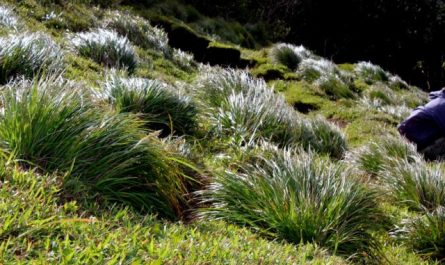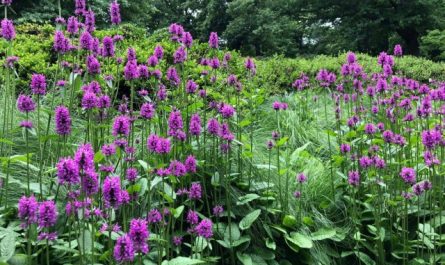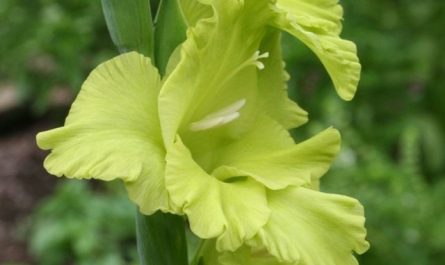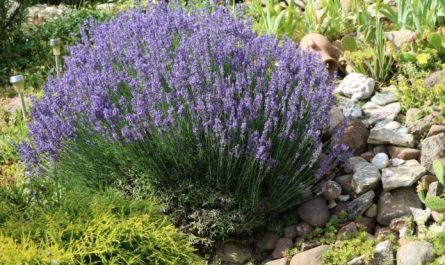Spring-flowering bulbous plants are rightfully considered to be among the most diverse plants in terms of decorativeness, color range and size. At the same time, tulips, daffodils, hyacinths and other bulbous plants are grown as seasonal garden decorations. Setting the tone for the entire spring and opening the season, spring bulbous plants quickly leave the garden stage. And they leave behind unattractive, withering greenery. Only thoughtful planting will allow you to ignore the shortcomings of these magnificent plants.
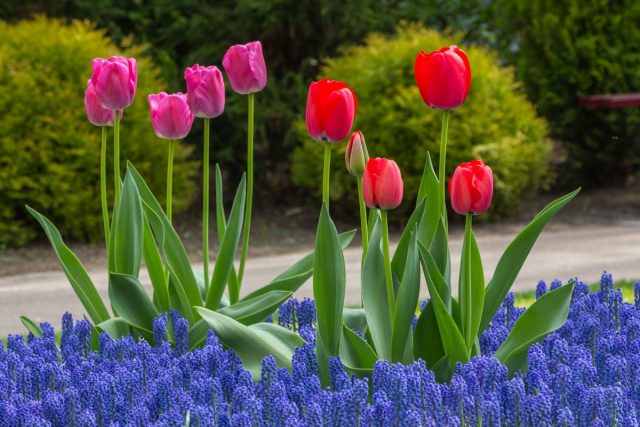
About the disadvantages of tulips, daffodils, hyacinths and Co.
Delicate, tremulous, charming or bold, always joyful, spring bulbous plants are a wonderful decoration for the garden. But they have one big drawback: they will not decorate the garden after flowering, and in many cases even before it. Their greenery is inconspicuous and modest, it begins to fade soon after flowering and cannot be trimmed.
Yellowing, wilted leaves on bare ground are not the best decoration for either a flower bed or a lawn. As are the empty spaces that remain after the plants finally go into dormancy. And there is only one way to avoid all the shortcomings of spring bulbous plants – to use such plants correctly.
Fortunately, there are many simple, classic or original solutions in the landscape design arsenal. And 5 such strategies can definitely claim to be the best options. These are fashionable ways to plant spring bulbs in the fall, which will allow you to enjoy their beauty in the spring without regretting the “consequences”.
1. Hide bulbs in carpets
Spring-flowering bulbs, especially primroses, are the best candidates for creating colorful glades and early bloom spots. But if you simply place them in a group, the spring spots will turn into the most unattractive place in the garden within a week after the last flowers have faded.
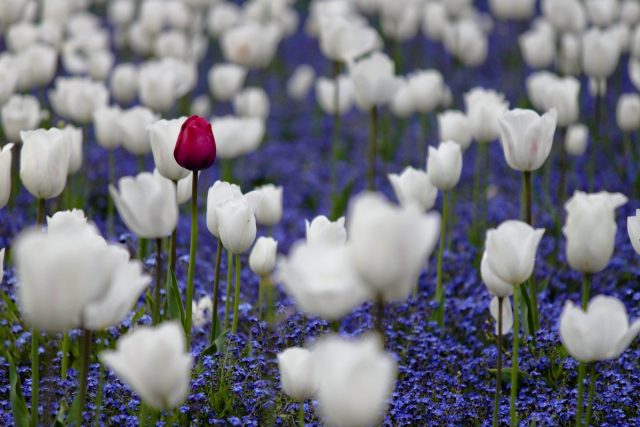
When adding landscape patches and spots of spring bulbs, it is worth considering the possibility of hiding flowers in existing garden “carpets”. Green lawns and all kinds of alternatives, including patches of groundcover and creeping shrubs, will not suffer at all if you hide spring flower bulbs in the turf and between plants.
They will literally transform the garden in spring and will serve as a colorful decoration until the beginning of the summer blooming riot. And the main “covering” will easily hide the shortcomings of fading greenery.
2. Introducing spring bulbs into perennial flower beds
Bulbous plants are primarily accent plants. They are used to create spring spots and colorful dots where the garden seems boring in spring. They should be introduced into flower beds and borders, mixborders and rockeries, added under late-waking shrubs, on alpine slides and even in borders.
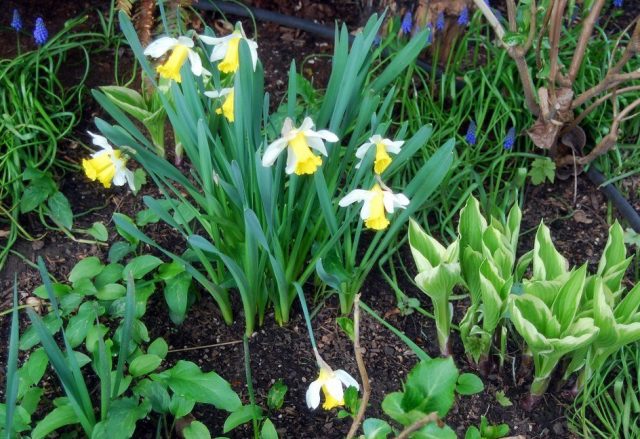
This technique is useful both as a seasonal gardening tool and as a way to disguise unsightly gaps after bulbs have finished flowering. All that is needed is to plant spring bulbs where the partners will then hide their fading leaves.
If bulbs are used in the middle ground, they can be planted with not very aggressive and late-awakening herbaceous perennials with lush foliage. They are placed between the main plants, in small groups.
A typical example of an ideal partner is hosta, which starts much later than all the main spring bulbous plants. But there is plenty to choose from: bush phlox, daylilies, ferns, heuchera, cuffs, astilbes, geraniums, as well as most popular perennials, will easily cope with the task.
If bulbs are used in the foreground or in a frame, they are combined with compact carpet perennials – from bright carpet phlox and silvery chickweed to bugleweed. In this case, bulbs are placed so that the main plants can mask their fading greenery.
Bulbous plants can be added to flowerbed and mixborder compositions both at the planning stage and by adjusting or supplementing ready-made compositions. They do not require large planting holes, and adding new plants in the fall along the perimeter of bushes, between perennials or near bushes will not be difficult at all.
3. Planting spring bulbs in tiers
Planting bulbous and small bulbous plants in tiers is a simple, ancient and very effective solution. Anyone who has created flower beds only from bulbous plants or planted them in baskets and pots is familiar with a simple method of planting in tiers – planting plants with different vegetation periods and different planting depths in peculiar layers.
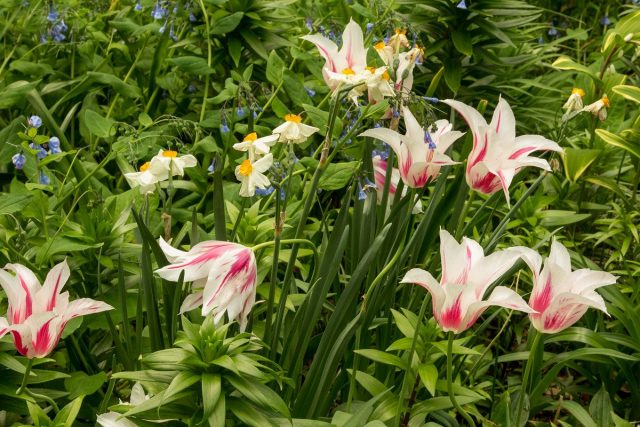
A typical example is planting tulips and crocuses or tulips and hyacinths in two “balls”. First, the largest bulbs are planted at the optimal depth, then they are carefully covered with soil and the usual planting of small bulbs is carried out.
But you can alternate bulbous plants only by flowering time. There are dozens of species in the huge class of bulbous and tuberous plants. They can be arranged in a kind of flowering relay race – from March and the melting of snow to frost. And having chosen your favorite species, you can create a composition in which some bulbous plants will effectively hide others.
One of the best candidates for masking the shortcomings of spring bulbous plants is anemone. Lush curly leaves appear late and easily hide the soil, the remains of foliage of any spring stars. Crocuses, muscari, daffodils, tulips, anemones, lilies, fritillaries – this is just one example of a mixed bulbous spot, in which late bulbous plants replace their fading colleagues.
4. Create seasonal mono-flower beds and borders
Flower beds with a single plant and small mono-flower beds are becoming increasingly popular. And it is no coincidence: there are few things that can compare in beauty with a strictly shaped flower bed, densely filled with orderly rows of hyacinths, daffodils or tulips.
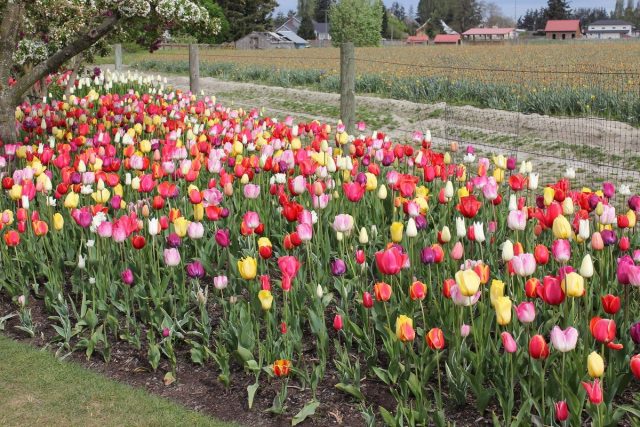
By maintaining the optimal distance when planting and planting bulbous plants in strict rows, the effect of a solid carpet of flowers is achieved. And the most complete disclosure of the beauty of the species.
Such bulbous flower beds can be perennial (permanent) or combined – created from species that require annual digging and then used for annuals.
In flowerbeds for annual plants, tulips and hyacinths, after being dug up, are simply replaced with seedlings of favorite annuals, creating a new colorful flowerbed of temporary plants every year.
When the annuals fade, bulbous plants are planted in their place again in the fall. Perennial, but exotic and non-wintering species that can be taken out into the garden only with the arrival of summer can also be used as such replacement partners. Cannas, gladioli, dahlias and even indoor bananas will happily settle in the place of tulips instead of petunias or pelargoniums.
5. Growing spring bulbs in containers
If you grow your favorite bulbous plants in pots, you won’t have any problems with their appearance in flower beds. Spring bulbous plants can be used to decorate terraces, paths, the entrance to the house, and recreation areas. It is easy to track varieties and create ideal conditions for flowers, removing containers as soon as the leaves begin to wither.
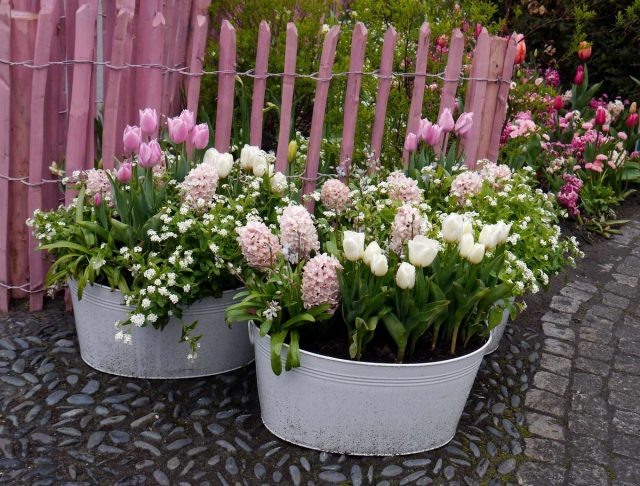
Growing tulips, daffodils, hyacinths and Co in flowerpots and pots has one big drawback – care. Bulbous plants in separate containers will be completely dependent on the owners and mistakes with watering or fertilizing will be critical for them. Complex compositions of different species or simple planting of one variety in a pot – it’s up to you to decide.
One of the forms of container culture that is becoming increasingly popular is digging. Bulbs are placed in large baskets, which after flowering are dug up and transferred to temporary places for ripening, literally “taking” them out of flower beds or lawns. Of course, this option does not go well with low-maintenance gardens and is not suitable for everyone.










